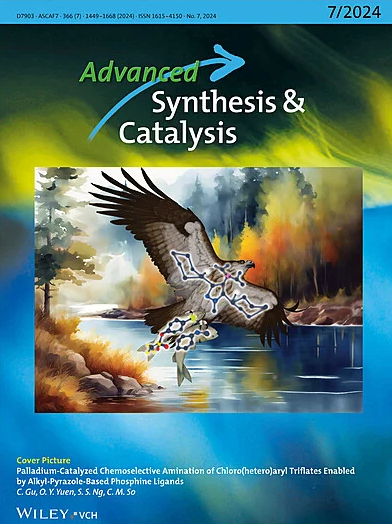Pd/BINAP/过氧化氢激活继电器多组分反应
IF 4
2区 化学
Q2 CHEMISTRY, APPLIED
引用次数: 0
摘要
近年来,多组分反应由于其从简单的起始材料构建复杂分子的效率而引起了人们的广泛关注。在此,我们报道了一个由BINAP/过氧化物控制的Pd催化的多组分反应,涉及易接近的吲哚、重氮化合物和烯丙基亲电试剂,能够有效合成结构多样的含氮季碳中心的N功能化吲哚,这些吲哚普遍存在于生物活性分子和药物中。该方法对N-H位点具有广泛的官能团耐受性和优异的区域选择性,尤其适用于未取代的吲哚。我们通过各种衍生化进一步证明了所得产物的合成效用,包括一个简明的四步合成矿皮质激素受体拮抗剂来治疗醛固酮介导的疾病。机理实验表明,该反应是由基于PdII/PdII非氧化还原和Pd0/PdII氧化还原催化循环的接力催化实现的,该催化循环分别促进了羰基和烯丙基底物的活化。研究发现,过氧化氢的加入抑制了[Pd0(BINAP)]物质的过早形成,并在反应开始时将钯保持在[PdII(BINAP)(OAc)2]形态,从而避免了不需要的吲哚烯丙化副产物的形成,并显著提高了目标产物的总产率。本文章由计算机程序翻译,如有差异,请以英文原文为准。
Pd/BINAP/Peroxide‐Enabled Relay Multicomponent Reactions
In recent years, multicomponent reactions have attracted considerable attention due to their efficiency in constructing complex molecules from simple starting materials. Herein, we report a BINAP/peroxide‐controlled Pd‐catalyzed multicomponent reaction involving readily accessible indoles, diazo compounds, and allylic electrophiles, enabling the efficient synthesis of structurally diverse N‐functionalized indoles bearing aza‐quaternary carbon centers, which are prevalent in bioactive molecules and pharmaceuticals. This approach exhibits broad functional group tolerance and excellent regioselectivity for N–H sites, especially applicable to unsubstituted indoles. We have further demonstrated the synthetic utility of the resulting products through various derivatizations, including a concise four‐step synthesis of a mineralocorticoid receptor antagonist to treat aldosterone‐mediated diseases. Mechanistic experiments indicated that this reaction was enabled by a relay catalysis based on PdII/PdII non‐redox and Pd0/PdII redox catalytic cycles, which was found to facilitate the activation of carbene and allylic substrates, respectively. The addition of peroxide was found to suppress the premature formation of [Pd0(BINAP)] species and keep palladium in the [PdII(BINAP)(OAc)2] form at the beginning of the reaction, thereby avoiding the formation of undesired indole allylation by‐products and significantly increasing the overall yields of the target products.
求助全文
通过发布文献求助,成功后即可免费获取论文全文。
去求助
来源期刊

Advanced Synthesis & Catalysis
化学-应用化学
CiteScore
9.40
自引率
7.40%
发文量
447
审稿时长
1.8 months
期刊介绍:
Advanced Synthesis & Catalysis (ASC) is the leading primary journal in organic, organometallic, and applied chemistry.
The high impact of ASC can be attributed to the unique focus of the journal, which publishes exciting new results from academic and industrial labs on efficient, practical, and environmentally friendly organic synthesis. While homogeneous, heterogeneous, organic, and enzyme catalysis are key technologies to achieve green synthesis, significant contributions to the same goal by synthesis design, reaction techniques, flow chemistry, and continuous processing, multiphase catalysis, green solvents, catalyst immobilization, and recycling, separation science, and process development are also featured in ASC. The Aims and Scope can be found in the Notice to Authors or on the first page of the table of contents in every issue.
 求助内容:
求助内容: 应助结果提醒方式:
应助结果提醒方式:


